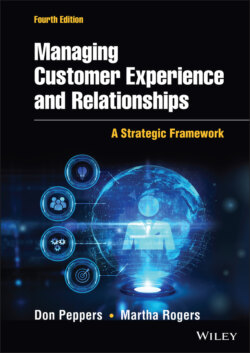Читать книгу Managing Customer Experience and Relationships - Don Peppers - Страница 43
Customer Experience Duality
ОглавлениеIn 1906, the British physicist J. J. Thompson was awarded the Nobel Prize for proving that the electron is a particle. In a deeply ironic twist of fate, 31 years later, in 1937, J. J.'s son George Thompson was awarded his own Nobel Prize for proving that the electron is actually a wave. So, who was right? Was it Thompson the elder or the younger? Actually, they were both right, because of the quantum mechanics principle known as wave-particle duality. A quantum entity can be described as either a particle or a wave, but once it is observed to be either, it will remain in that same observed state for the rest of eternity. It's just the way the universe works.
In the customer experience discipline, we could say there is a kind of customer-experience duality as well. And this principle can be illustrated by a story one of the authors encountered in the late 1990s at Australia's St. George Bank (now part of Westpac). On a consulting visit we had a meeting one morning with the marketing folks at St. George who introduced us to their new ATMs, which had been programmed to remember individual customers and to offer them customized services based on their history and their observed preferences. You could put your cash card into the St. George Bank ATM, enter your PIN code, and the machine might display the message “Welcome, Mr. Jackson. Would you like your usual $100 cash from your checking account, no receipt?” and Mr. Jackson could simply press “yes” or “no.” Choosing “yes” meant he could get his usual cash withdrawal and leave, while choosing “no” would give him access to all the other ATM's various functions, including deposits, transfers, information lookups, and so forth.
Today, of course, virtually every bank's ATMs operate in a similar way, but at the time (the 1990s) this was a very novel form of personalization. One of the authors banked at Citibank during this period and had to begin every ATM transaction by selecting to use English in addition to identifying which account, how much, receipt or not, and so forth. Every week required inputting the same choices and the same answers. So at St. George Bank we complimented the marketing folks for having cracked the code on personalizing and streamlining their ATM customer experience.
Later that afternoon we met with the computer folks at the bank, and we complimented them, too, on the improved level of service their ATM software was providing to customers. But one of the IT managers scoffed at the very idea that this innovation had been done for customer-service reasons. “Customer service had nothing to do with it,” he said. “So why then,” we asked, “had the bank programmed its ATMs in this way to make things so much easier for customers?”
The IT manager replied that they were solving a different problem entirely, because real estate for placing ATMs, in Sydney, Australia, was quite expensive and difficult to come by. He explained that these changes allowed an ATM to serve a lot more customers in the same amount of time.
So who's right? Is it better service? Or lower cost? They're both right. It's customer experience duality.
In a valuable customer experience, there are no hidden costs or pricing tricks, and the value proposition should be good for both sides of the transaction—seller as well as buyer. The value that any customer perceives in an enterprise's product or service bears a direct connection to how important or urgent the customer understands their need to be. Since customers have different opinions about these needs, they will have different opinions about the value of an enterprise's offering. We know this to be true because there is an economic principle that someone who considers the value of an offering to be higher than its price will likely buy it, while someone who considers its value lower than its price will likely not. Moreover, the value delivered in any customer's experience will increase directly in proportion to the amount of friction that is removed. Because friction is frequently costly to a company, removing it can also provide compounding benefits for both the customer and the enterprise.
